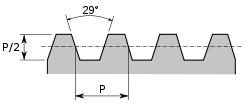Thread angle

Diagram of a thread angle
The thread angle of a screw is the angle between the threads.[1] This is a defining factor for the shape of a screw thread. Standard values include:
| Name | Code | Angle | Profile | Standards |
|---|---|---|---|---|
| Most V-threads (including ISO, NPT and UTS) |
M | 60° |  |
DIN 13 / ISO ? / ASME/ANSI ? |
| Whitworth threads | W | 55° |  |
DIN 49301 / BS ? |
| G | 55° |  |
DIN / BS / EN / ISO 228-1 / ISO 7-1 | |
|
Rd | 30° |  [5] [5] |
DIN 405 / DIN 20400 |
| Acme thread[6] | 29° |  |
ASME/ANSI B1.5-1988[7] | |
| Metric trapezoidal threads[1] | Tr | 30° |  |
DIN 103 |
| Buttress threads[6] | S | 45° |  |
DIN 2781 |
| German buttress threads[6] | S | 30° |  |
DIN 513 |
| Square threads[1] | Sq | 0° |  |
? |
|
Pg | 80° |  |
DIN 40430 |
| British Association (BA) thread | BA |
|
? | BS 93:2008 |
| Löwenherz thread[8] | ? |
|
? | ? |
| Bodmer thread[9] | ? | 50° | ? | ? |
References
Notes
- 1 2 3 Bhandari 2007, p. 203.
- ↑ Knuckle Thread DIN 405
- ↑ Knuckle Thread DIN 20400
- ↑ Bornemann
- ↑ Knuckle thread
- 1 2 3 Bhandari 2007, p. 204.
- ↑ Green 1996, p. 1716.
- ↑ Löwenherz thread
- ↑ Bodmer thread
Bibliography
- Bhandari, V B (2007), Design of Machine Elements, Tata McGraw-Hill, ISBN 978-0-07-061141-2.
- Oberg, Erik; Jones, Franklin D.; Horton, Holbrook L.; Ryffel, Henry H. (1996), Green, Robert E.; McCauley, Christopher J., eds., Machinery's Handbook (25th ed.), New York, NY, USA: Industrial Press, ISBN 978-0-8311-2575-2, OCLC 473691581.
This article is issued from Wikipedia - version of the 11/26/2016. The text is available under the Creative Commons Attribution/Share Alike but additional terms may apply for the media files.